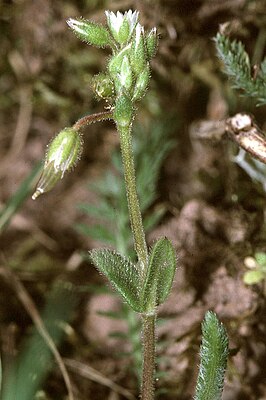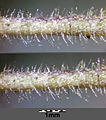Pale hornwort
| Pale hornwort | ||||||||||||
|---|---|---|---|---|---|---|---|---|---|---|---|---|

Pale Hornwort ( Cerastium glutinosum ) |
||||||||||||
| Systematics | ||||||||||||
|
||||||||||||
| Scientific name | ||||||||||||
| Cerastium glutinosum | ||||||||||||
| Fr. |
The pale hornwort ( Cerastium glutinosum ), also called sticky hornwort , is a species of plant in the carnation family (Caryophyllaceae).
Appearance
Cerastium glutinosum ( herbarium evidence )
This one to two year old herbaceous plant reaches heights of about 2 to 20 cm and is light green in color. The stem grows more or less upright and is covered with a few glandular hairs. It is never reddish at the bottom.
The leaves are oblong or ovate to lanceolate, the lowest with short stalk. All bracts and the sepals have a very narrow skin margin in front. They are bald on top.
It blooms from March to May. The petals are white and about 2.5 times as long as they are wide. There are usually six to ten stamens present.
The fruit stalks are more or less upright and are about as long as the calyx. But they can also be bent at the tip with a hook and then two to four times longer than the cup. The elongated, cylindrical capsule fruit pops up with ten teeth.
The number of chromosomes is 2n = 72.
Location claims and distribution
The pale hornwort grows in gappy dry grass , on paths and rainy areas. It prefers dry-warm, nutrient-rich and lime-rich, neutral-mild, loose stone, clay or loess soil. It loves warmth. In Central Europe it is a species of the Sedo-Scleranthetea class, but also occurs in gappy societies of the Festuco-Brometea class. Cerastium glutinosum is a sub-Mediterranean-subatlantic floral element, the exact distribution of which is still insufficiently known. It occurs in Europe and the Middle East.
In Austria only common in the Pannonian region , otherwise rarely, in Switzerland quite rarely. The pale hornwort occurs in the central part of Germany. Otherwise it is apparently very rare.
Systematics
The species was previously regarded as a subspecies of the dark hornwort ( Cerastium pumilum ) and as Cerastium pumilum subsp. pallens (FW Schultz) Schinz & Thell. designated. Further synonyms are: Cerastium semidecandrum subsp. glutinosum (Fr.) Čelak. , Cerastium glutinosum subsp. pallens (FW Schultz) Schinz & R. Keller , Cerastium pallens (FW Schultz) FW Schultz .
literature
- Henning Haeupler , Thomas Muer: picture atlas of the fern and flowering plants of Germany (= the fern and flowering plants of Germany. Volume 2). Published by the Federal Agency for Nature Conservation. Ulmer, Stuttgart 2000, ISBN 3-8001-3364-4 .
- Wolfgang Adler, Karl Oswald, Raimund Fischer: Excursion flora of Austria. Ed .: Manfred A. Fischer . Ulmer, Stuttgart / Vienna 1994, ISBN 3-8001-3461-6 .
- August Binz , Christian Heitz: School and excursion flora for Switzerland , Schwabe & Co. AG, Basel, 1986, ISBN 3-7965-0832-4
- Erich Oberdorfer : Plant-sociological excursion flora , Ulmer Verlag, Stuttgart, 1990, ISBN 3-8001-3454-3
- Christian August Friedrich Garcke : Illustrierte Flora , 1972, Paul Parey publishing house, ISBN 3-489-68034-0
Individual evidence
- ↑ a b c d Letz DR, Dančák M., Danihelka J. & Šarhanová P., 2012: Taxonomy and distribution of Cerastium pumilum and C. glutinosum in Central Europe. - Preslia 84: 33-69; cf. Corrections as well as taxonomic and floristic supplements and updates to the 3rd edition (2008) of the excursion flora for Austria, Liechtenstein and South Tyrol in Neilreichia 7 ( Memento of the original from April 21, 2016 in the Internet Archive ) Info: The archive link was inserted automatically and has not yet been checked . Please check the original and archive link according to the instructions and then remove this notice. , P. 238
- ↑ a b Erich Oberdorfer : Plant-sociological excursion flora for Germany and neighboring areas . 8th edition. Verlag Eugen Ulmer, Stuttgart 2001, ISBN 3-8001-3131-5 . Page 377.
- ↑ Karol Marhold, 2011: Caryophyllaceae : Datasheet Cerastium pumilum In: Euro + Med Plantbase - the information resource for Euro-Mediterranean plant diversity.
Web links
- Cerastium glutinosum. In: FloraWeb.de.
- Distribution map for Germany. In: Floraweb .
- Cerastium glutinosum Fr. In: Info Flora , the national data and information center for Swiss flora . Retrieved October 12, 2015.
- Distribution in the northern hemisphere according to Eric Hultén
- Thomas Meyer: Data sheet with identification key and photos at Flora-de: Flora von Deutschland (old name of the website: Flowers in Swabia )






